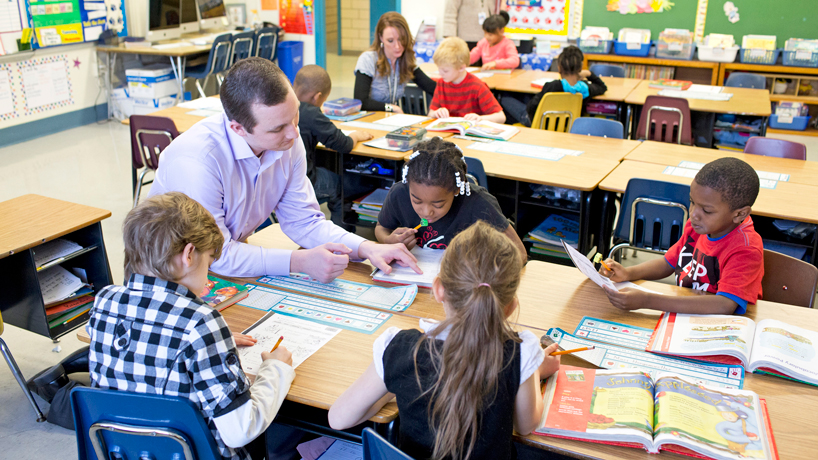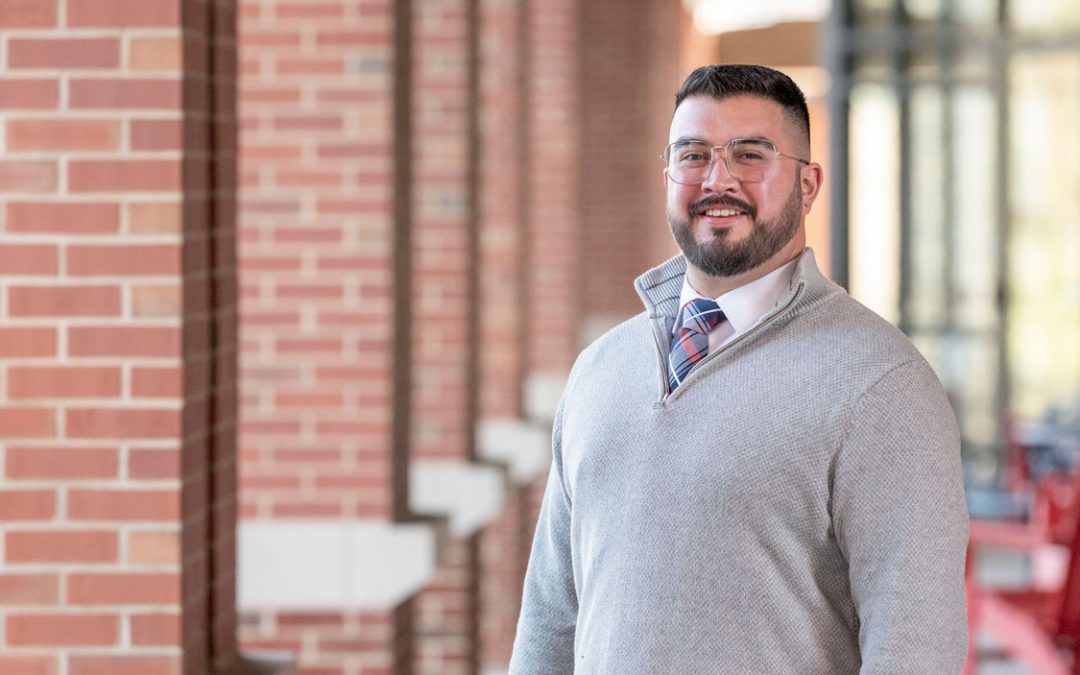
More than 90 graduating teacher candidates from the College of Education designed final projects that they put into action at their studio school practicum sites this past semester. The SAIL projects are an integral part of UMSL’s top-ranked teacher preparation. (File photo by August Jennewein)
How does a new teacher build relationships with his or her students?
What would happen if an entire community came together to encourage children to get excited about math and science?
How would the experience of learning a classic text change for a student who suddenly gets to own a copy of that text for the very first time?
More than 90 graduating teacher candidates from the College of Education at the University of Missouri–St. Louis were able to answer these questions and many others on May 5 as they gathered together in the Ed Collabitat on UMSL’s South Campus.
The students assembled to present insights and reflections from the School Adventure into Learning (SAIL) projects that they conducted during the last semester of their teaching practicum experiences.
The SAIL project requirement is just one piece of an innovative and engaging teacher prep puzzle that earned the college high marks on the Missouri Department of Elementary and Secondary Education’s Annual Performance Report for Educator Preparation Programs in March.
“It all starts with those questions – with any question,” explained Stephanie Koscielski, director of clinical experiences and school partnerships. “Essentially, we tell our teacher candidates to try something – to explore some aspect of their teaching style or practicum experience that makes them curious – and then to create an artifact to share what they learned.”
If the prompt seems like a simple one at first, Koscielski added, that’s because it is – purposefully so.
“We’re opening the possibility for our teacher candidates to have some intellectual freedom over what they want to study, and we’re also providing them with a creative outlet to investigate their own practice and determine what kind of educator they want to be,” she said. “Our underlying hope is that we ignite a spark of passion not just for teaching, but for the core belief in the role of educator as researcher.”
Judging by the vast and creative directions in which the students take their projects, that spark is working.
At Kratz Elementary in the Ritenour School District, student teachers Lori Karasek, Jessica Boresi, Corinthian Johnson, Courtney Mast, Kelsey Schumacher and Stephanie Tripp investigated the benefits of one-on-one tutoring with their students.
At Fox High School, Ben Llufrio and Megan Cunningham developed a film society.
At Lewis and Clark Elementary in Fort Zumwalt, Jessica Wallace, Kalyn Sanders and Megan Weber had their students participating in interactive journaling.
In multiple other schools, UMSL teacher candidates chose to focus on fostering an interest in science, technology, engineering and math in their students. The recent STEM Night at Zitzman Elementary was just one example.
Koscielski was quick to note that in addition to the students’ efforts, it’s the studio school model the College of Education employs that really makes a huge difference for the development of some of the projects.
“We’re deeply committed to our studio school partners and to their students’ learning,” Koscielski said. “They know about the students’ SAIL efforts and often offer guidance and full support that’s remarkable for our students’ learning and progress as educators.”
Thanks to the model’s collaborative design, over 30 local schools throughout the St. Louis area partner with UMSL as clinical education sites for the teacher candidates. Far more extensive than the traditional student-teaching experience, UMSL’s future teachers get to spend an entire year in practicum. They get to teach in teams, in different classrooms, and they quickly become fully integrated into the culture of the schools.
A commitment to developing that culture often serves as the jumping-off point for many of the SAIL projects.
This was the case at Parker Road Elementary in the Ferguson-Florissant district, where Christopher Pearson, Margaret Ries and Stephanie Dirnbeck helped launch a weeklong candy-gram initiative that had students sending friendly notes to classmates.
Known as “buddy bunnies,” the chocolate rabbits and accompanying messages – “I hop you have a nice day” – kept young students laughing and bridging their differences while also raising funds.
Pearson and his UMSL peers used the money to provide a commemorative plaque that will adorn the “buddy bench” the student council members were working to build and install in the school as a trusted place where friendships could be formed and connections made. The students themselves will ultimately decide what friendly and encouraging message goes on the plaque to solidify the bench’s meaning.
The entire effort centered around creating an environment where every student feels more safe and less alone, Pearson said.
Other UMSL students saw the SAIL project as an opportunity to explore ways to strengthen curriculum.
For Leo Jalipa, it was an avenue for enriching his Roosevelt High School sophomores’ experiences with Shakespeare.
As he prepared to teach a unit on “Macbeth” using the standard curriculum workbooks he noticed tend to “chunk up” the play, Jalipa wondered what would happen if he could keep them, but supplement them with the Bard’s original text.
“I wanted to offer my 10th graders a chance to break away from that workbook approach, which can be daunting and impersonal, and thus less engaging,” Jalipa said. He turned to crowd sourcing with the hopes that he would be able to buy each of his students their own copy of the classic tragedy – a first for many of them. “There’s just something to be said for owning a book, an artifact of one’s own learning.”
Via a GoFundMe page, he shared his mission and purpose.
“I have learned so much and love every single one of my students,” he wrote. “I want to be able to give back to them.”
In just 10 hours, he raised nearly double what he had hoped for.
He closed his campaign with enough funds to buy the play for his three sections of students and a fellow teacher’s class as well. Extra donations were used to buy a classroom set of the graphic novel version of “Macbeth” – something he says turned out to be another great supplementary tool.
“I often used the graphic novel to differentiate in my lesson planning and during instruction,” he said. “The students really enjoyed being able to see illustrations of the text.”
As for how the students responded to having their own copies, Jalipa says it was well worth the effort.
“I think that this opportunity really enhanced their experience of what could have been a very difficult unit. The looks on their faces when they found out the books were theirs to keep is something I’ll never forget.”















